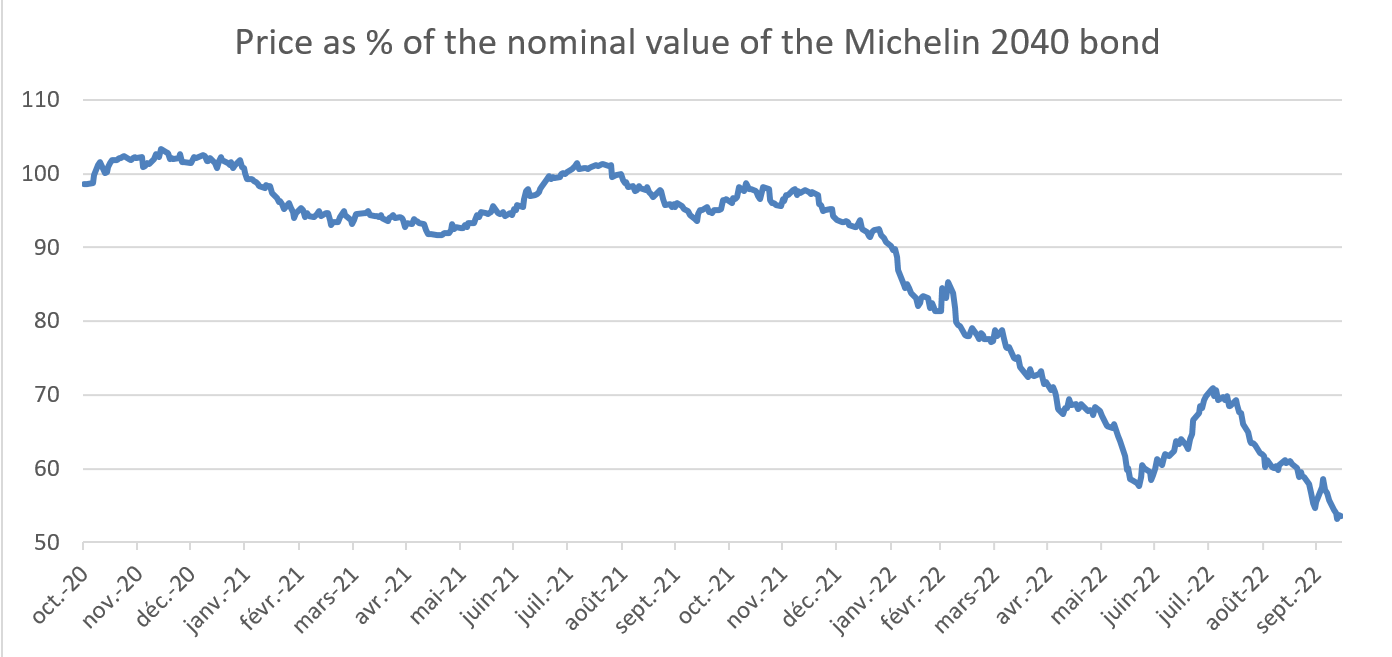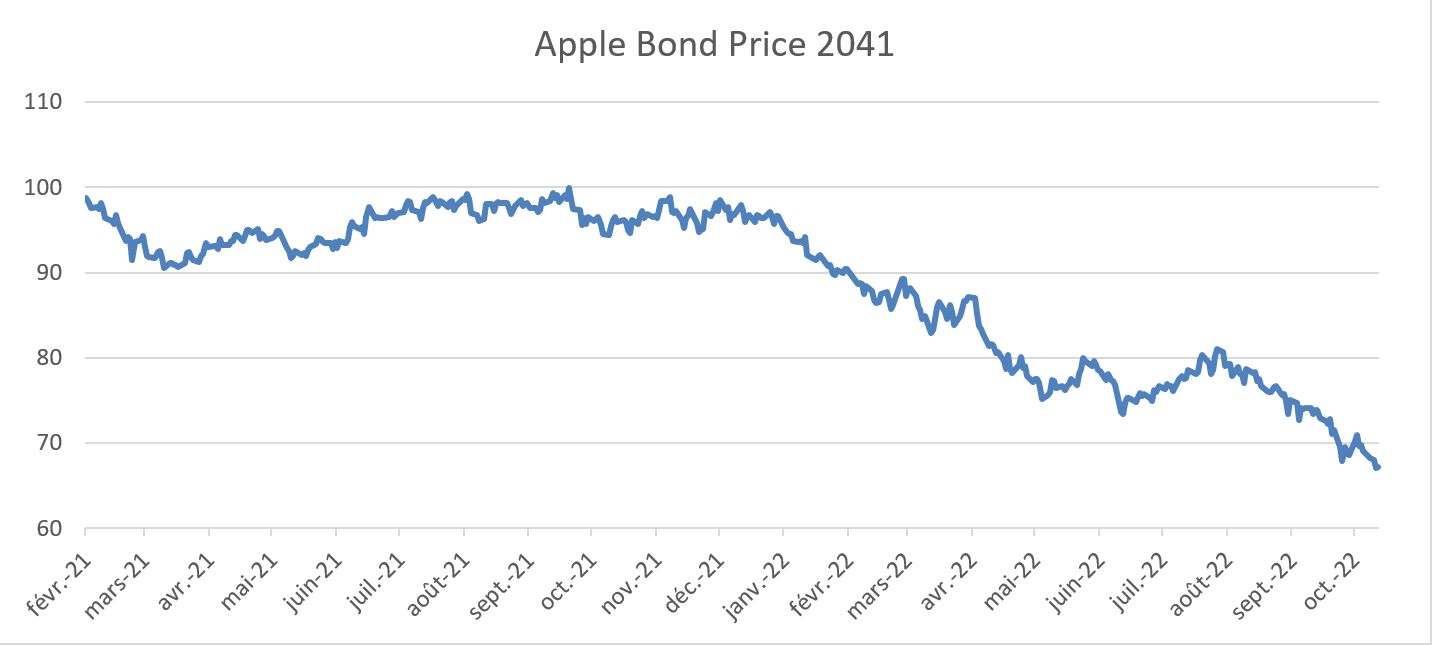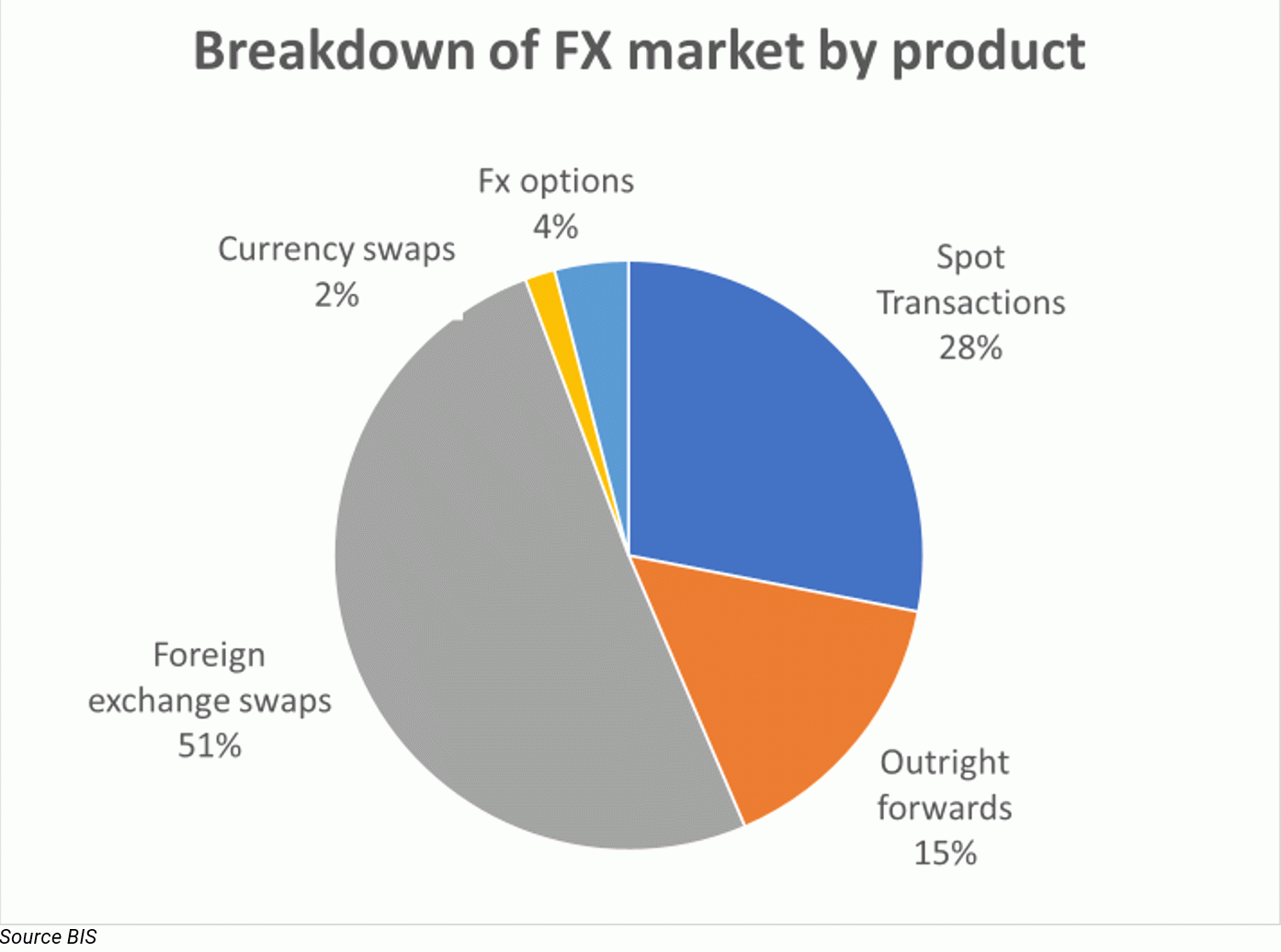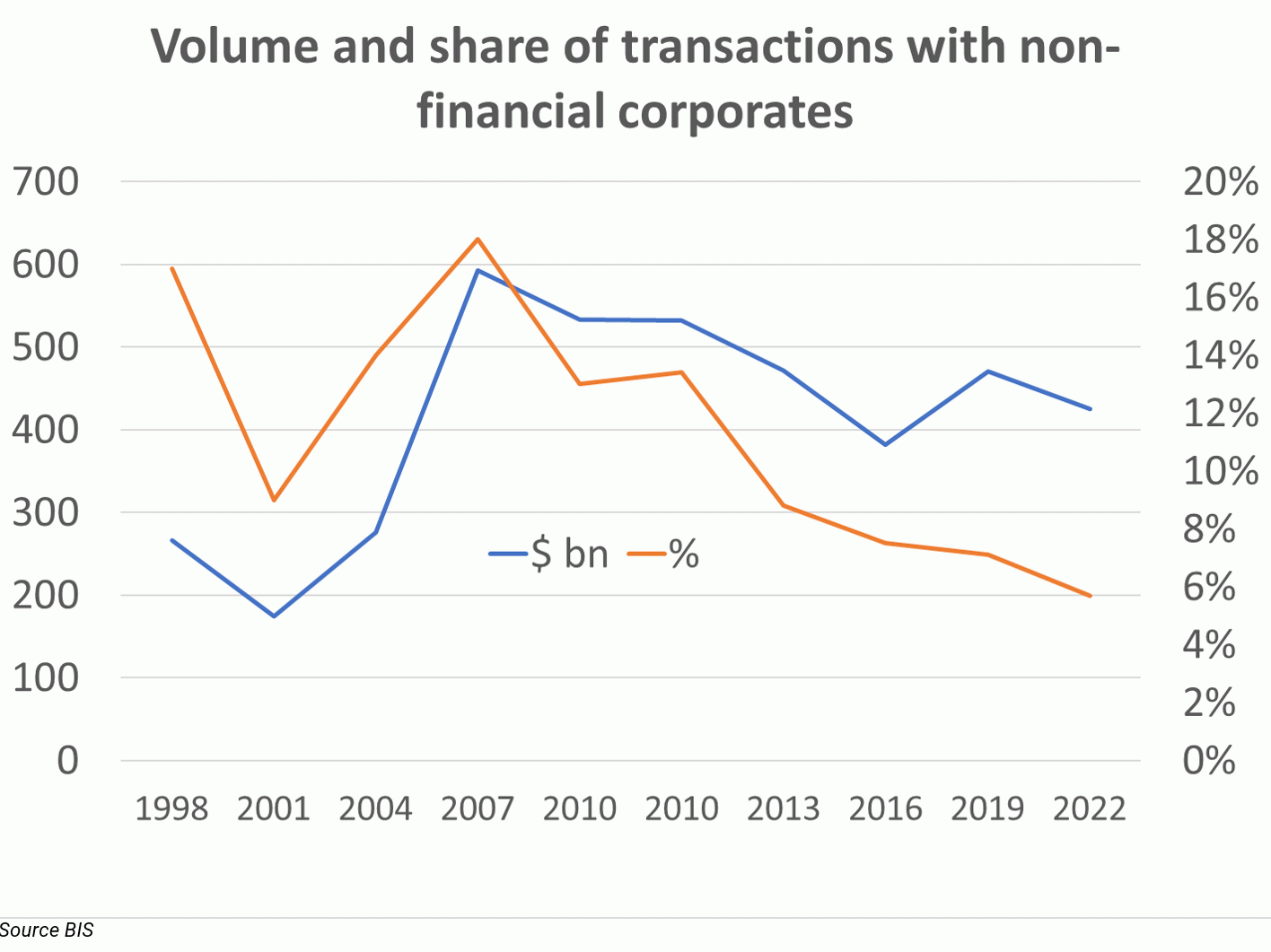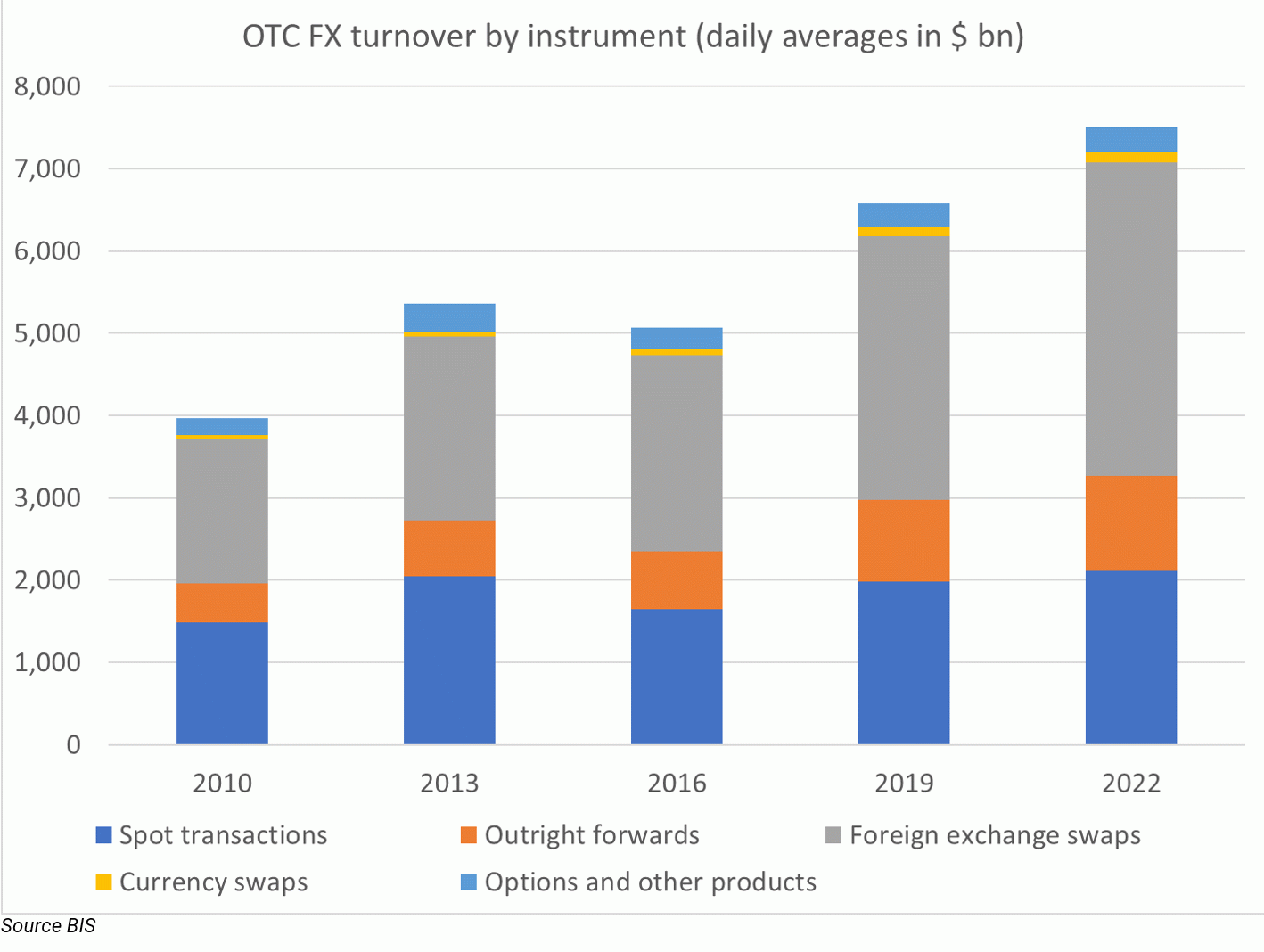Letter number 147 of January 2023
- TOPIC
- STATISTICS
- RESEARCH
- QUESTIONS & COMMENTS
- NEW
News : Should companies buy back their bond debt?
In October 2020, Michelin issued a €500 million bond with a 20-year maturity and a coupon rate of 0.625%. Happy times!
Today, this bond, listed on the stock exchange at 53.6% of its nominal amount, has a yield-to-maturity of 4.4%.
It isn’t, of course, that Michelin's perceived ability to repay its debt on time has deteriorated. It's just that interest rates have risen since then, as everyone has noticed. And, with a sensitivity[1] of 16.1, the impact on the value of the Michelin bond of rising interest rates is massive.
The tyre manufacturer was thus able to issue this bond in October 2020 at mid-swap[2] + 63 basis points. Today, its price should show a yield-to-maturity at mid-swap + 125 basis points. In other words, if the spread, due to the quality of Michelin's signature, has relaxed a little with the lesser intervention of the central bank on interest rates, the main part of the fall in the price of the Michelin 2040 bond is due to the change in the mid-swap interest rate, which has risen from - 0.03% to 3.15%.
A similar trend can be seen in the Apple 2.375% 2041 bond, which is currently trading at 67% of its $1.5bn face value:
with a spread that went from 84 basis points at issue in February 2021 to 130 basis points today, and a yield-to-maturity that went from 2.45% at issue to 5.17% today. Although it can be said that in a competitive sector such as the automotive industry, Michelin is by no means assured of its survival in 20 years, this is much less certain for the world's largest market capitalisation, based on a cash cushion of $189 billion and net bank and financial debt of -$16 billion.
From a financial point of view, the 46% discount of the Michelin bond price on the nominal value corresponds to the present value over the remaining life of this bond, 18 years, of the difference between the current market rate for a Michelin bond of this maturity, 4.4%, and the coupon rate of 0.625%.
If Michelin wanted to buy back this debt on the market, and except for using cash assets, which would reduce its liquidity, it would have to issue a new bond to finance the buyback, at the current market rate, i.e. for the same maturity, of around 4.4%.
From a financial point of view, there would be no gain or loss, since it would buy back its debt at its value, except for the premium paid to buy back the 2020 bonds, but on the bond markets, these are very low (1 or 2%), and far from those of the equity market. In these conditions there is thus no significant financial interest to do so.
From an accounting point of view, Michelin would record a non-recurring capital gain of €500m x 45%, assuming a buyback at 55% of the nominal value, i.e. €225m; pay corporate tax at 25%, i.e. €56m, and increase its equity by the net amount, i.e. €169m; and replace an annual charge of 0.625% x €500m = €3.1m in its profit and loss account with another €500m x 55% x 4.4% = €12.1m. Of course, the negative impact on the result could be reduced by refinancing the repurchased debt by issuing debt with a shorter duration, and therefore with a lower interest rate, now that the interest rate curves have returned to their normal shape. However, this would be at the cost of taking on additional risk. On the balance sheet, the €500m debt would be replaced by a €225m debt. So, a reduced result for more book equity and less financial debt, at least for those who can't see beyond their own nose and take the debt at its book value and not at its actual value.
Accordingly, the interest a company would have in buying back its listed debt is not evident. But under what conditions would such an operation make sense?
One possibility could be the case of a company with surplus cash that would like to reduce its carrying cost, the gap between the cost of its debt and the return on its cash. However, the advantages of doing so are not all that clear. Due to the rise in interest rates, companies making short-term investments benefit - or will soon benefit - from an interest rate that is higher than the nominal rate of their old bonds. €STER is currently at 0.66%, and the 3-month Euribor is at 1.4%. So even in this scenario, reducing liquidity to reduce the bottom line does not seem like a good idea.
Because of the accounting and tax treatment of the operation, a company emerging from significant difficulties, that has issued debt at low rates before getting into difficulties and to which lenders are willing to lend, could be concerned. It could thus rebuild its equity more quickly, which, whatever people may say, always looks bad when it is negative or reduced, and reduce the face value of its debt; at no tax cost to it, given the accumulated losses. This is not, however, such a common occurrence.
There is also the case of a company that would like to send out a signal on its liquidity, like Credit Suisse which, by proposing to buy back €3 billion of its senior debt at the beginning of October, triggered a 7% jump in its share price (after a fall of more than 50% in 2022). It is true that when your CDS goes from 130 bp to 590 bp (sic) in one week, danger is looming, especially when you must, as a bank, borrow much more regularly than a company.
In fact, it seems to us that the real subject of this theme is going to be that of taking into account the value of the debt instead of the book value stated in company valuations arrived at by indirect methods (multiples of gross operating surplus, operating result or discounted free cash flow).
Of course, there is no doubt[3] that in terms of valuation, the value of net debt takes precedence over its book value, but until now the subject has mainly concerned companies whose perceived solvency had deteriorated significantly, i.e. fairly marginal cases. Now, it is potentially all groups, because what financial director was so unaware or incompetent as not to issue long-term debt in these once-in-a-lifetime interest rate conditions?
The publication of the 2022 accounts in a few weeks’ time will show the estimated value of financial debt in the notes, making it easier for analysts to do their job properly.
The discount on this Michelin bond alone represents 1.4% of the group's equity value. This means that we believe that the financial director should pay a great deal of attention to the question of whether or not it should be bought back. He’s going to have to keep a close eye on the situation!
[1] For more details on the sensitivity of bonds, see chapter 20 of the Vernimmen 2022.
[2] If you've forgotten what mid-swap means, this month's Q&A is for you.
Statistics : The Forex market
The Foreign Exchange (FX) market represents daily average volumes of $7,506 bn split among the following products:
FX swaps represent the majority of the volumes with spot transactions accounting only for 28%.
The share of corporates has been decreasing in time since 2007 and now only represent 5.7% of daily global volumes:
Volumes of transactions have almost doubled since 2010 (and been multiplied by close to 10x since 1992). Growth has been largely fed by the increase in swaps contracted by financial institutions :
New-York and London represents more than 50 % of transactions.
Most active currencies are the US dollar (88 % of forex transactions have a $ leg), the Euro, the Yen, the UK pound, and the Renmimbi.
Research : Dividend taxation and its impact on investment policies
With Simon Gueguen, lecturer-researcher at CY Cergy Paris University
As a social science, finance is not a good field for establishing clear causalities. The consequences of tax reforms affecting dividends or share buybacks are a good example. This kind of reform has potentially multiple consequences: on the distribution policy of companies, on cash management, on investments, etc. As all of these elements are interdependent, it is difficult to isolate and correctly measure the different effects.
In this kind of situation, the ideal would be to carry out a full-scale experiment, with a perennial, unanticipated reform that affects only some companies in order be able to establish a control group. Sometimes political decisions provide such a working space. The article we present this month[1] exploits a reform that has these qualities.
In 2011, a tax reform in Switzerland affecting capital contributions[2] led to the possibility for some listed companies (about half of them) to pay untaxed dividends to their shareholders. This reform is perennial[3] , unanticipated, it only concerns some companies, and it is massive (the tax rate is reduced to zero). By comparing the companies concerned by the reform and the others, it is therefore possible to measure its effects fairly well.
The first question is the impact of the reform on the distribution policy of companies. Previous studies on this topic have produced mixed results. In 2003, a tax cut on dividends in the US led to a significant increase in dividend payments. However, a study[4] showed that share buybacks fell by the same amount, so that actual distribution of cash to shareholders did not change.
In the case of the Swiss reform, however, the effects are very marked. The rate dividend yield rose sharply for the companies concerned; all other things being equal, it increased by 0.672% (compared to an average rate of 2%). At the same time, companies that did not benefit from the reform maintained the same rate. Also, this increase is not offset by a decrease in share buybacks, so that the total payout ratio has also increased.
The second and more difficult question concerns the impact of the reform on investment policy. In general, the authors do not observe any difference in the investment policies of the two groups of companies. It thus seems that the abolition of taxation on dividends, leading to their increase, does not affect (or not significantly) the investment policy. To understand this phenomenon, the authors study the use of cash in the two groups of companies. The increase in the payout ratio mechanically leads to a decrease in cash holdings in the companies concerned. Not only do these companies not compensate for this effect by reducing share buybacks, but they also do not compensate for it by increasing capital. As a result, the cash available for investment is reduced.
Isakov et al suggest that there are two opposing effects. On the one hand, the tax reduction on dividends reduces the cost of equity (and the total cost of financing), as investors take this into account when calculating their required returns. This provides an incentive to invest because there are more value-creating projects. On the other hand, this tax advantage encourages more cash distribution and, as this distribution is not offset, the cash available for investment is reduced. The net effect, on the sample studied, is zero.
Finally, the article shows that the reform has not achieved its primary goal: to promote investment. However, the profound effect of the reform on companies remains to be studied. By eliminating the taxation of dividends for shareholders, the reform has strongly reduced the tax advantage of debt, often considered as a distorting element in the choice of financing. The authors consider that the reform may have reduced the agency problems arising from this distortion. They also note with some mischief that Swiss banks were allowed, after the subprime crisis[5] [5] , to pay tax-free dividends to their shareholders as compensation for their obligations to rebuild equity. In the light of the conclusions arrived at in this article, the effectiveness of this measure should be re-examined.
[1] D.Isakov, C.Perignon and J.P.Weisskopf (2021), What if dividends where tax-exempt? Evidence from a natural experiment, Review of Financial Studies, vol.34(12), pages 5765 to 5795.
[2] An equity contribution by existing shareholders and recorded in the balance sheet as reserves, offering the possibility of a tax-free repayment.
[3] Or at least presented as such, it is about taxation...
[4] J. R. Brown, N. Liang and S. Weisbenner (2007), Executive financial incentives and payout policy: firm responses to the 2003 dividend tax cut, Journal of Finance, vol.62, pages 1935-1965.
[5] For more details on subprime lending, see Vernimmen.com Newsletter No. 28.
Q&A : What are the two types of interest rate curves?
The term interest rate curve can cover various similar concepts but with certain nuances that can be crucial (especially when used for asset valuation purposes).
There are two main categories: market interest rate curves and derived interest rate curves.
Market-observed interest rate curves can be further divided into swap rate curves and bond rate curves. They are constructed from observable market quotations: mainly government bond prices for the bond yield curve, and swap rates for the swap yield curve. The bond curves are the term structure of the prices of bonds quoted on the market, while the swap curves are the term structures of swap rates (and term deposits). The 3-month swap curve is the base curve.
Market observable curves cannot be used directly for valuation. They must be transformed into zero-coupon derivative curves that are essential for asset valuation.
Derived interest rate curves relate interest rates to the maturities of notional zero-coupon instruments. The zero-coupon yield curve is the best approximation of the risk-free curve and serves as a benchmark for all bond valuations. The liquidity of the underlying instruments is crucial. Since the swap market is a very liquid market with narrow bid-ask spreads and a wide selection of maturities, the curves derived from swap curves offer several advantages over government curves. Therefore, they are generally chosen by market participants.
Because of the simple relationship between zero rates and discount factors, zero rate curves are becoming a dominant valuation vehicle in the market. Whether financial market participants refer to interest rate curves, yield curves, zero rate curves, or spot rate curves, they actually mean the same thing.
Note that the U.S. Treasury only publishes observed yield curves, whereas the Bank of England, the Bank of France or the European Central Bank publish a zero-coupon yield curve, for example (recalculated from government bond yield curves).
New : Comments posted on Facebook
Regularly on the Vernimmen.com Facebook page[1] we publish comments on financial news that we deem to be of interest, publish a question and its answer or quote of financial interest.
Here are some of our recent comments.
Very interesting quarterly results from Procter and Gamble
P&G has just published its results for the quarter ending 31 December, which show a 1% decline in quarterly sales. However, it would be wrong to stop at this figure as its breakdown is very illustrative of the current economic situation. The - 1% is the result of 3 main effects:
1/ A price effect of +10% because P&G has increased its prices by about the inflation given the strength of its brands.
2/ A volume effect of - 6% as consumers reduced their consumption of P&G products, probably to buy cheaper products such as private labels. Moreover, the decline in volume was strongest in the Fabric & Home Care (Ariel, Cash, Lenor) and Grooming (Braun and Gillette) divisions, -7 and -8%, where price increases were the strongest: 13 and 11% respectively.
3/ A currency effect of -6%, given the strength of the dollar over the past year.
The effective corporate tax rate of 18% (coming from 19 % the previous year) is a sobering figure given that the main countries where P&G operates all have higher corporate tax rates, and that its main competitor, L'Oréal, was at 22.5% in the first half of 2022. By this measure and over a year, that's about $1bn that is lost for the world's tax authorities, for P&G alone.
Renault Nissan: divorce at the back of the class.
Presented as a new beginning for the Renault-Nissan alliance, the terms of the new partnership are, in our opinion, similar to a divorce between two players who, from a financial point of view, have become marginalized over time, with respective market capitalizations of €11 and €13 billion, compared to 4 times more for Stellantis (Peugeot, Fiat, Chrysler), €46 billion, and 14 times more for Toyota (€180 billion).
In the 2021 ranking of car sales, the Renault-Nissan-Mitsubishi Alliance is ranked third worldwide with 7.7 million vehicles sold, compared with 10.5 million for the leader (Toyota) and 8.9 million for Volkswagen. On this basis, Renault alone will be in 10th place, and Nissan in 8th, more in line with their market capitalization.
Sure, by gradually selling 28% of Nissan, Renault can recover at the current price a little less than €4bn, but that's only one-sixth of Stellantis' operating cash flow in 2022..., and of course, a non-recurring amount.
The sad moral of this story is twofold. Convoluted schemes and shaky governance rarely lead to industrial, let alone financial, success. They are too complicated, synergies are not found, national sensitivities are protected and maintained by the coexistence of two entities. Moreover, it is rarely good to be a shareholder alongside the State when the latter is directly involved, as the Agnelli family had the intelligence to understand when they broke off advanced merger negotiations with Renault to marry Peugeot and create Stellantis, in the face of the procrastination of the State, Renault's largest shareholder.
As for those who are worried about how Renault will replace the fraction of Nissan's dividends that will disappear from its results, let them be reassured. That is not the issue. The issue is industrial first and foremost. The proceeds from the sale of the 28% will be reinvested in Renault's activities and will generate results higher than the share of dividends lost, if the investments undertaken return their cost of capital.
De-risking your retirement savings or getting poorer?
There is a principle generally observed and applied to pension funds and employee savings for retirement, sometimes even automatically, which is to mechanically reduce the share of shares and to increase just as regularly the share of bonds and money market investments as the beneficiary of the fund approaches retirement age in order to de-risk his/her savings. While this principle may seem relevant and prudent, it should be noted that its application over the last 15 years has been catastrophic, leading to a relative, if not absolute, impoverishment of those who were persuaded to enter into such an automatic pilot.
Indeed, continuously reducing the share of equities in the portfolio from 2007 onwards has led to a failure to benefit from the price recovery since 2009: at the end of 2007, the Eurostoxx50 was at 4400, fell in February 2009 to 2000, before regaining nowadays nearly its 2007 level Increasing the share of bonds over the past decade has meant investing more and more in products that yield less and less or none at all, or even seeking yield by choosing the longest securities. That is to say, those that have fallen the most since the rise in interest rates, because a low coupon rate and a long duration give a very high sensitivity. For example, the Michelin 2040 bond issued at the end of 2020 with a coupon of 0.625% is currently only quoted at 61% of its nominal value, i.e. a loss of 39% in 2 years because, with a modified duration of 18, the slightest rise in rates is reflected in the price multiplied by a factor of ... - 18.
It is true that those who had a mainly bond portfolio in 2009 were able to benefit from the fall in rates until 2021, but with shorter securities and less sensitivity due to higher coupon rates. Thus a fall in rates from 4% to 0.625% only leads to a 26% increase in the value of a bond with an initial duration of 7 years, and 20% if this fall is not instantaneous but observed over 2 years. Not enough, however, to avoid relative impoverishment, nor absolute impoverishment due to rising interest rates as the portion of maturing bonds not used to pay pensions was reinvested in long term bonds with reduced coupon rates.
So what should we do?
Define an incompressible amount invested in risk-free monetary assets, which could correspond for example to 10 years of expected retirement or to half of the funds, and invest the balance in shares, a pocket that is gradually liquidated to pay the first years of retirement. The last pensions being paid by the least risky pocket, because at the end of one's life the appetite for risk naturally tends to reduce. And above all, regularly question the relevance of the rule adopted to avoid any automatic pilot which seems to us to protect the asset manager more than its customer.
